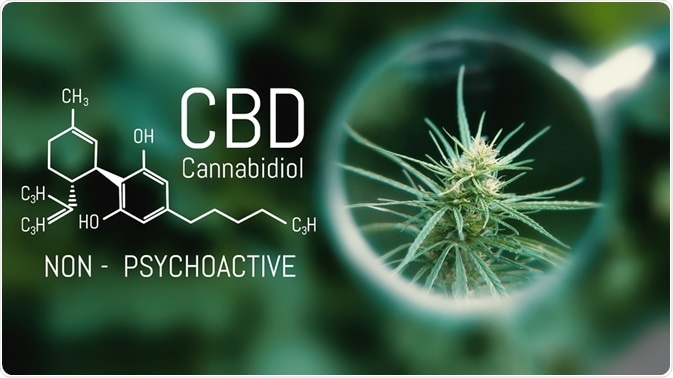The recreational use of psychoactive substances has become increasingly popular over recent years, particularly amongst young party-goers. Some manufacturers have taken advantage of this emerging trend, offering low-cost, man-made versions of naturally occurring psychoactive substances, with novel creations being promoted regularly.

Image Credit:Shutterstock/PRO Stock Professional
Many of the new substances reaching the market recently are in the form of synthetic cannabinoids.1 These designer drugs are produced from man-made chemicals designed to create comparable effects to the active ingredient in cannabis - delta-9 tetrahydrocannabinol (THC).
These substances are sold as safe and legal cannabis alternatives, with small changes in their chemical structure meaning that they are not included in lists of prohibited substances, therefore not subjected to legislated quality control procedures.
While employed purely for recreational purposes and for their impact on mood and the user’s state of consciousness, these synthetic cannabinoids can have a major impact on the functioning of the brain and nervous system, often with serious consequences.
Some structural differences from the imitated compound have led to compounds that are more biologically active than THC. These carry a high risk of seizures, psychosis, and coma.2 Many of these compounds are not always accurately described when sold online, meaning that the drug’s potency could actually be considerably different than expected. This, of course, gives rise to the risk of serious adverse effects.
Synthetic cannabinoids were first identified in 2008, as part of designer drug mixes. Since then, the European Monitoring Centre for Drugs and Drug Addiction (EMCDDA) has reported and identified over 179 of these compounds with new psychoactive substances continuing to be introduced to the market.3
While synthetic cannabinoids are seeing widespread use, there have been few studies into the human pharmacokinetics of these compounds.4
In both forensic and clinical settings, it is important to be able to verify both the intake and identity of a synthetic cannabinoid via the analysis of biological samples. In order to do this effectively, some information on the drug’s metabolism is necessary to determine whether urine or serum analysis would be more useful.
Synthetic cannabinoids
Synthetic cannabinoids are commonly employed as an alternative to cannabis. They are marketed as ‘legal’ and ‘safe’ alternatives to cannabis and, due to their easy availability online, and because of this they are rapidly gaining popularity. In order to evade detection and regulation, new compounds are constantly in development.
The term ‘synthetic cannabinoid’ describes a sizable class of chemical compounds that activate the same neuroreceptors as THC. While these compounds all mimic the effects of cannabis, they possess a diverse range of structures, leading them to having various extra effects on the body. The majority of these are characterized by an indole or indazole core structure.
The manufacture of synthetic cannabinoids is primarily clandestine, and as a result of this covert approach, there are no regulatory standards for the manufacture, packaging, or sale of synthetic cannabinoid chemicals. Because of this lack of standardization, there is no guarantee that the compound bought has not been contaminated with other chemicals, or even that it is, in fact, the compound stated on the label.
Synthetic cannabinoid products are regularly contaminated with toxic chemicals or other drugs, which can result in severe morbidity or even fatalities. The concentrations of synthetic cannabinoids may also differ substantially between packets with identical labelling, potentially leading to users inadvertently taking much higher doses than intended.
A range of indazole-based synthetic cannabinoids were identified in Japan between 2013 and 2014,5 including AB-PINACA, AB-FUBINACA, and 5F-AB-PINACA. Numerous intoxications and deaths have been reported where individuals have consumed these compounds, but detailed information around their in vivo pharmacology and toxicology have yet to be recorded.6,7
The aminoalkylindazole compound 5F-ADB is considered to be one of the most hazardous synthetic cannabinoids, being linked to approximately ten fatal intoxications in Japan.8
Recent discoveries have identified synthetic cannabinoids with a 7-azaindole (7-AI) core structure like AB-FUBINACA. These compounds are harder to identify as they possess similar physicochemical properties and identical masses to corresponding indazole analogs.9
These compounds are difficult to detect in the body, prompting major concerns, not least in determining the cause of a patient’s condition should they present for emergency healthcare.
Chemical characterization of 5F-AB-P7AICA
To help improve understanding of the metabolism of these recent additions to the synthetic cannabinoid market, a characterization study was recently conducted on the 7-azaindole analog of 5F-AB-PINACA.9
The test compound - advertised as the 'research chemical' ABFUB7AICA - was purchased online.
Structural characterization was undertaken via nuclear magnetic resonance spectroscopy (NMR), infrared and Raman spectroscopy and gas chromatography-mass spectrometry. NMR spectra of the pure research chemical 5F-AB-P7AICA were aquired using a Bruker AVANCE III HD 500 spectrometer fitted with a 5 mm CryoProbe.
Phase I metabolites were produced through the application of a pooled human liver microsome assay in order to confirm the analysis results of authentic urine samples obtained following oral self-administration of 2.5 mg 5F-AB-P7AICA. These were quantified using liquid chromatography-time-of-flight mass spectrometry with a Bruker Impact II™ qToF instrument working alongside a Bruker Elute HPLC system.
The main phase I metabolites detected in human urine samples had been formed by hydroxylation, hydrolytic defluorination and amide hydrolysis. Concentrations of the parent compound were found to be greater than those of the metabolites, in contrast with the majority of other synthetic cannabinoids.
This concentration-time profile is best explained using a two-phase pharmacokinetic model, with 5F-AB-P7AICA being detected in urine samples up to 65 hours after ingestion.
These most recent findings in relation to the metabolism of the latest addition to the synthetic cannabinoid market suggests that effective monitoring of the parent 5F-AB-P7AICA in urine samples may be as vital as the identification of main metabolites during routine urine screening.
References
- United Nations Office of Drugs and Crime (UNODC). The challenge of new psychoactive substances. Available at https://www.unodc.org/documents/scientific/NPS_2013_SMART.pdf.
- Tai S, Fantegrossi WE. Curr Addict Rep. 2014;1(2):129 136.
- European Monitoring Centre for Drugs and Drug Addiction (EMCDDA). European Drug Report; 2019: trends and developments. Publications Office of the European Union, Lisbon. http://www.emcdda.europa.eu/publications/edr/trends-developments/2019
- Castaneto MS, et al. Drug Metab Rev. 2015;47(2):124-174. https://doi.org/10.3109/03602532.2015.1029635
- Uchiyama N, et al. Forensic Toxicol. 2014;32(2):266-281.
- Armenian P, et al. Neuropharmacology. 2018;134:82-91. https://doi.org/10.1016/j.neuropharm.2017.10.017
- Yamagishi I, et al. Leg Med (Tokyo). 2018;35:44-49. https://doi.org/10.1016/j.legalmed.2018.08.004
- Kusano M, et al. Drug Test Anal. 2018;10(2):284-293.
https://doi.org/10.1002/dta.2215
- Immadi SS, et al. Cannabis Cannabinoid Res. 2018;3(1):252-258. https://doi.org/10.1089/can.2018.0046
- Giorgetti A, et al. Drug Test Anal. 2020;12:78–91. DOI: 10.1002/dta.2692
About Bruker BioSpin - NMR, EPR and Imaging

Bruker BioSpin offers the world's most comprehensive range of NMR and EPR spectroscopy and preclinical research tools. Bruker BioSpin develops, manufactures and supplies technology to research establishments, commercial enterprises and multi-national corporations across countless industries and fields of expertise.
Sponsored Content Policy: News-Medical.net publishes articles and related content that may be derived from sources where we have existing commercial relationships, provided such content adds value to the core editorial ethos of News-Medical.Net which is to educate and inform site visitors interested in medical research, science, medical devices and treatments.